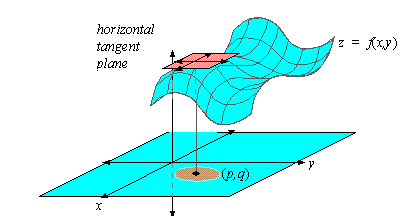Critical Points
In this section, we develop a method for finding the extrema-i.e.e, the
maximum and minimum points-of a function of two variables. For reasons
which will soon be apparent, this method is called the second
derivative test.
To begin with, we say that a function f(x,y) has a local maximum at a point ( p,q) if there is a circle
of radius R centered
at ( p,q) such that
for all (x,y) in that circle. That is, f(p,q)
is the maximum height of some small patch of the surface, although it may
not be maximum overall.

Tan circle has radius R.
It follows that if |h| < R, then
f(p+h,q) £ f(p,q) and thus
Dividing by h when 0< h < R and letting h approach 0
from the right yields
|
fx(p,q) = |
lim
h®0+
|
|
f(p+h,q) - f(p,q)
h
|
£ 0 |
| |
Conversely, dividing by
h when -R< h < 0 and letting h approach 0 from the
left yields
|
fx(p,q) = |
lim
h®0-
|
|
f(p+h,q) - f(p,q)
h
|
> 0 |
| |
Consequently, it must follow that
fx(p,q) = 0. A similar argument shows that
fy(p,q)
= 0.
That is,
the tangent plane to the graph of f(x,y) is horizontal at a local maximum or local minimum.

Similar results hold if f(x,y) has a local minimum at a
point ( p,q) since this is equivalent to -f( x,y) having a local maximum at ( p,q) .
Definition 8.1: The critical points of a function f(x,y) are those points ( p,q) for which
|
fx( p,q) = 0 and
fy(p,q) = 0 |
|
By the discussion above, the extrema of f( x,y) must
occur at its critical points.
EXAMPLE 1 Find the critical point(s) of
Solution: The first partial derivatives are
|
fx( x,y) = 3x2-3y, fy( x,y) = -3x+3y2 |
|
Setting fx and fy equal to zero leads to 2 simultaneous equations:
Simplifying leads to y = x2 and x = y2, which implies that x = x4.
Since x = x4 is the same as x4-x = 0, we obtain
|
x( x3-1) |
= |
0 |
| x( x-1) ( x2+x+1) |
= |
0 |
|
which results in x = 0 and x = 1. Since y = x2, we have x = 0 implies y = 0, while x = 1 implies y = 1. Thus, the critical points are (0,0) and ( 1,1) .
Check your Reading: Why does y = x2 and x = y2
imply that x = x4?


